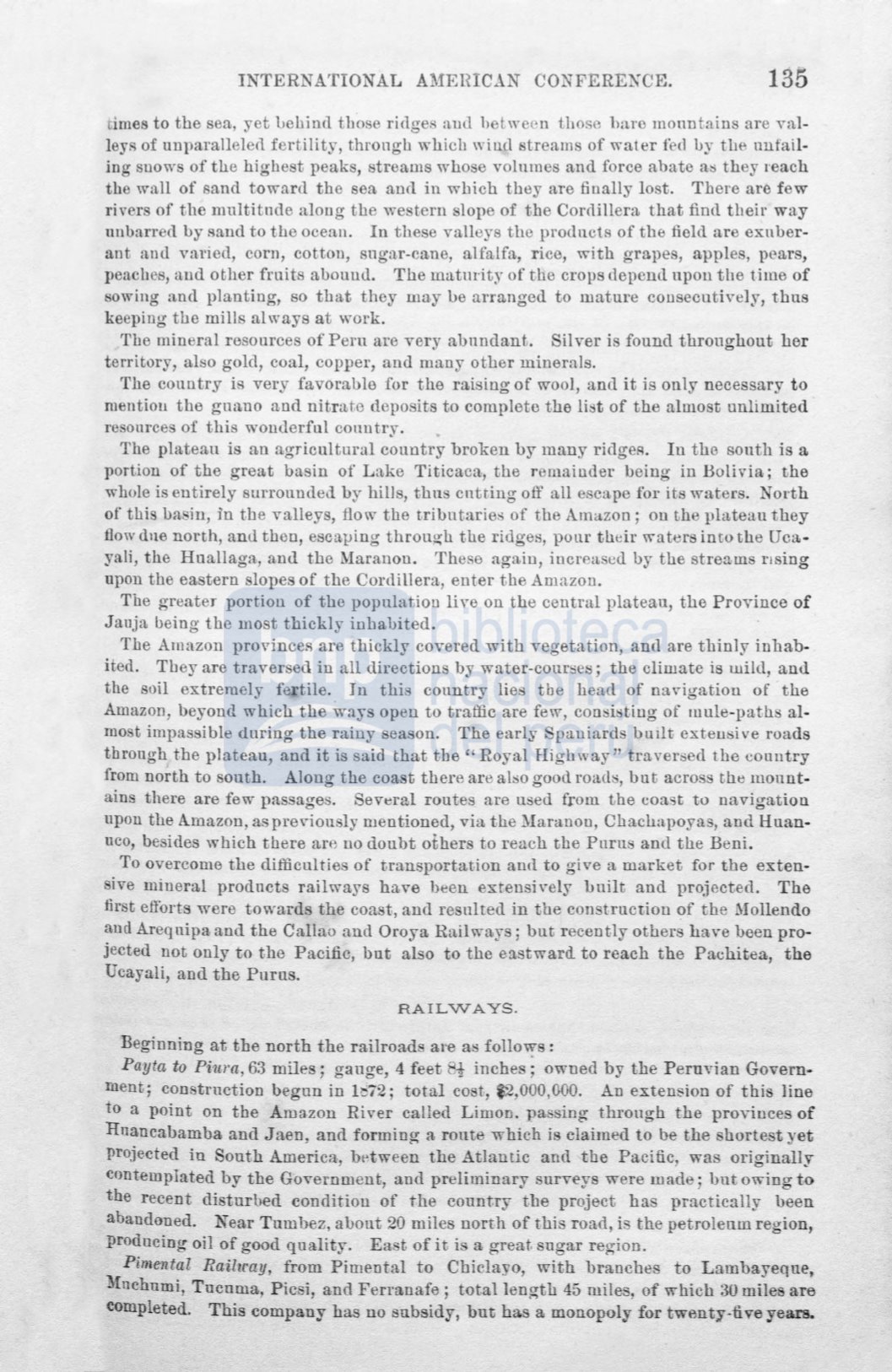

INTERN.A.TION.A.L .
A.MEIUC.ANCONFERENCE.
135
times to the sea, yet uehind tbose ridges n,nu bet ween those bure monn tains are val–
leys of unparallelerl fertilüy, throngh whicb wiud streams of water ferl by the uufail–
ing suows of the highest peaks, streams whose volumes and force abate a:s they reach
the wall of sand toward the sea and in wbich they are finally lost. Tbere are few
rivers of tbe mnltitnde along tbe western slope of tbe Conlillera that find their way
unbarred by sand to tbe ocean. In these valleys the products of the field are exnber–
ant anu varied, corn, cotton, sngar-caue, alfalfa, rice, with grapes, apples, pears,
peacbes, and other fruits abound. The matmity of the crops depeud upon tbe time of
sowing and planting, so that they ma.y be urranged to mature consecutively, thus
keeping the mills al ways at work.
The mineral resources of Peru are very abundaut. Silver is found throughout her
territory, also gold, coal, copper, and many other minerals.
The country is very favorable for the raising of wool, and it is only necessary to
mentiou the guano and nitra,te deposits to complete the list of the almost unlimited
resonrces of this wonderful country.
The platean is an agricultura! country broken by many ridges. In the south is a
portion of the great basin of Lake Titicaca, the remaiuder being in Bolivia; the
whole is entirely surrounded by hills, thns cntting off all escape for its waters. North
of this basin, in the valleys, fiow the tributarios of the Amazon; ou the pla,teau they
flow dne north, and then, escaping through the ridges, pom· their waters into the Uca–
yali, the Huallaga, ami the Maranou. These again, iucreased by the streams nsing
upon the eastern slopes of the Cordillera, enter the Amazon.
The greater portiou of the population
li
ve on the central platean, the Province of
Jauja being the most thickly inbabited.
Tbe Amazon provinces are thickly covered with vegetation, and are thinly inhab–
ited. Tbey are traversed in all directions by water-courses; the climate is wild, and
the soil extremely fertile. Ju this country lies tbe head of navigatiou of the
Amazon, beyoud which the ways opeu to traffic are few, consü;ting of mule-paths al–
most impassible during the rainy season. The early Spaniards bmlt exteusi ve roads
tbrough the platean, and it is said that the "Royal Highway" traver:sed the country
from north to south. .A.long the coast there are
al~:;o
good road:s, bu t across the mount–
ains there are few passages. Several routes are used from the coast to navigation
upou the Amazon, as previously mentioned, via the Maranon, Chachapoyas, and Huan–
uco, besides wbich there are no doubt others to reach the Purns and the Beni.
To overcome the difficulties of transportation and to give a market for the exten–
siva mineral prodncts railways have been extensively built and projected. The
tlrst efforts were towards the coast, and resnlted in the constrnctiou of the Moliendo
and Arequipaand the Callao aud Oroya Railways; but recently others have been pro–
jected not only to the Pacific, but also to the eastward to reach the Pa<.:hitea, the
Ucayali, and the Purus.
RAILW"AYS.
Beginning at tbe north the railroads are as follows:
Payta to
Piw·a,
63 miles; gauge, 4 feet
8t
incbes
¡
owned by the Pernvian Govern–
ment; constrnction begun in
1~72
·
total cost, $2,000,000. .A.n extension of this line
to a point on the Amazon River called Limon. pa sing through the proviuces of
R nancabamba and
J
aen, and forming a route which is claimed to be the shortest yet
projected in South .A.merica, bP-tween the .A.tlantic and the Pacific, wa originally
contemplated by the Governmeut, and prelitninary surveys were made; but owing to
the recent clisturbed conditiou of the country the project has practically been
abaudoned. Near Tumbez, about 20 miles north of this road, is the petroleum region,
producing oi1 of good quality. East of it is a great.suo-ar region.
Pimental Railtcay,
from Pimental to Chiclayo, with brancbes to Lambayeque,
Mnchnmi, Tucoma, P ie
i,
and Fermnafe; total length 45 miles, of which 30 miles are
completed. This company has no subsidy, but has a monopoly for twenty-tive years.
















